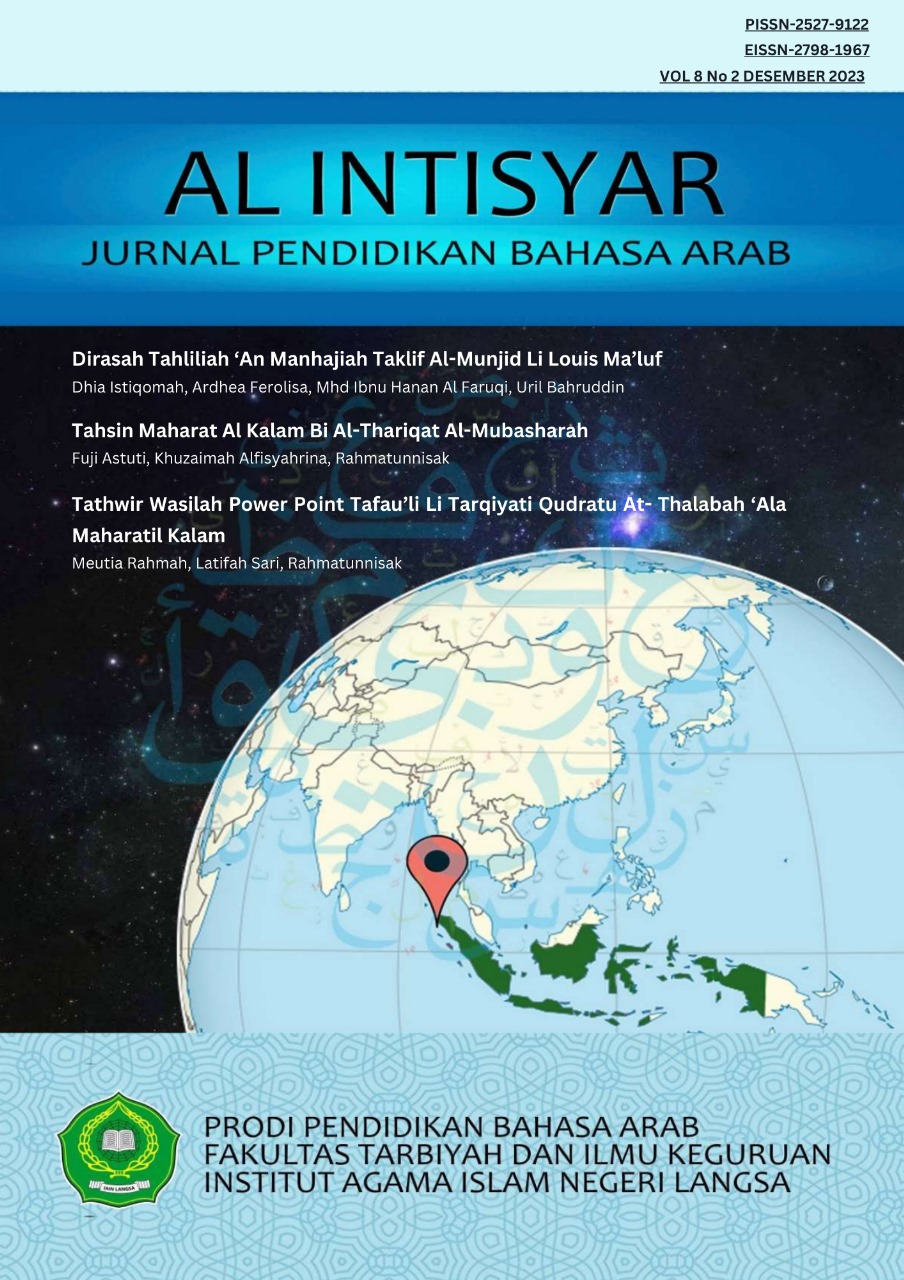Dirasah Tahliliah `An Manhajiah Ta'lif Al-Munjid Li Louis Ma`luf
An Analytical Study On the Methodology of Writing Al-Munjid by Louis Ma`luf
Abstract
Al-Munjid is a popular dictionary that contains hundreds or even thousands of vocabulary words, so many people use it even in almost all parts of the world. The aim of this study was to introduce the author to Al-Munjid Dictionary, the method of writing Al-Munjid and the method of revealing words in it, and the advantages and disadvantages of Al-Munjid Dictionary. The method used in this study is qualitative with a library research design. The data collection technique for this research is to search for data, read data, tag data, and list data related to information contained in books, journals, proceedings, print media, and online media. The results of this research: First, Al-Munjid dictionary uses the lexical grouping method that relies on the method of arranging alphabetical patterns. It is included in several forms of dictionaries, and it is also included in several specific lexical objectives. Second: Some scholars believe that Al-Munjid's dictionary is connected and part of the Orientalist work that concealed the duties and goals of global Islam. Third: Al-Munjid's dictionary contains five advantages and eight disadvantages.
Downloads
References
Ahmad Zaky, ‘Perkembangan Dalalah’, WARAQAT : Jurnal Ilmu-Ilmu Keislaman, 2.1 (2020), 24
Anwar, Saepul, and Muhammad Thabrani, ‘منهج معجم المنجد ÙÙŠ اللغة والأعلام للويس معلو٠؛ دراسة ÙÙŠ ترتيب المداخل’, 2021
Arifin, Ahmad, ‘PERSEPSI MAHASISWA TERHADAP PENGGUNAAN KAMUS DIGITAL BAHASA ARAB DI ERA SOCIETY 5.0’, An Nabighoh, 23.2 (2021), 235–50
Azzahra, Siti Fatimah, ‘PENYUSUNAN KAMUS KEDOKTERAN ARAB – INDONESIA DENGAN PENDEKATAN LINGUISTIK’, Jurnal Pendidikan Bahasa Dan Sastra Arab, 2.2 (2020), 60–66
Hakim Ahmad Luqman; Rikza Ferdian, ‘Sistematika Penyusunan Kamus Berdasarkan Entri , Jumlah Bahasa , Dan Masa / Periode’, Makalah, 2011 (2013), 1–10
https://salafiyunpad.wordpress.com/2009/10/16/qam
ISMAIL, MUHAMMAD MARWAN, and WAN MOHARAANI BIN, Kajian Semantik Dan Mu’jam ’Arabiy, 2009
Kamil, Sukron, ENSIKLOPEDI BAHASA DAN SASTRA ARAB, 2018
Rifa’i, H Ilyas, ‘Mengenal Kamus Arab-Indonesia Mahmud Yunus’
Riska Hayati, Nova Ratna Sari Harahap, and Erlina, ‘Analisis Komponen Dilalah Dalam Bahasa Arab’, El-Jaudah : Jurnal Pendidikan Bahasa Dan Sastra Arab, 2.2 (2022), 95–117
Shofwatul Fuadah, ‘المنهج وطريقة كش٠الكلمات ÙÙŠ معجم المنجد للويس معلوÙ’, Lahjah Arabiyah: Jurnal Bahasa Arab Dan Pendidikan Bahasa Arab, 2020, 77–88
Subhan, Muhammad, ‘Telaah Diksi Agama Dalam Kamus Al-Munjid Fi Al-Lughah Wa’, 8.1 (2023), 28–41
Taufiqurrahman, H. R., ‘Leksikologi Bahasa’ (UIN Malang, 2008), p. 142
Ulfiyah, Kamus al-Munjid, (Institut Agama Islam Negeri Walisongo, 2012) http://chiaraoelivia.blogspot.co.id/2013/06/kamusmunjid.html diakses pada 10 April 2020, pukul 02.55 WIB.
Wahida, Besse, ‘KAMUS BAHASA ARAB SEBAGAI SUMBER BELAJAR (KAJIAN TERHADAP PENGGUNAAN KAMUS CETAK DAN KAMUS DIGITAL)’, Jurnal Pemikiran Pendidikan Islam, 11.1 (2017), 58–71
ابرهيم عوض، املرجع السابق، ، ص. 10
ابرهيم عوض، النزعة النصرانية ÙÙŠ قاموس المنجد، الطائÙØŒ دار الÙاروق1991ØŒ ص. 7
عبد الØميد Ù…Øمد أبوسكين, ’المعاجم العربية مدارسها مناهجها الÙاروق الØرÙية للطباعة والنشر‘, 1971
عبد الØميد Ù…Øمد أبو سكين, ’المعاجم العربية مدارسها مناهجها : ١٢٤
عبد الكريم الرديني, ’المعجمات العربية : ١٢٩-Ù£Ù
Ù†Ùس املرجع ØŒ ص. 11











